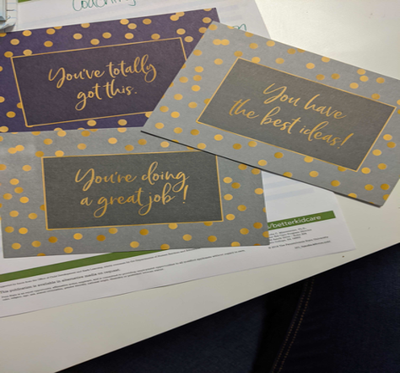Posted: February 23, 2021
CAT and gratitude? Let me explain. As professionals, we are “noticers.” We notice and observe by listening, questioning, and being a witness to the efforts and strengths of children, families, and our peers in our early learning programs. As noticers, we support what early childhood coach and author Cathy Toll (2019) calls CAT: Connectedness, Acceptance, Trustworthiness.

Connectedness, Acceptance, Trustworthiness
One of the most effective ways to build trusting, positive relationships is by expressing sincere thankfulness and gratitude. For example, as we notice and affirm the positive efforts, strengths, and curiosities of others, we notice the goodness in each other and in our communities. We can then share our appreciation by conveying our gratitude and thankfulness for the work and efforts of others. Practicing gratitude has proven to be one of the most reliable methods for increasing happiness and is shown to boost feelings of optimism, joy, enthusiasm, and other positive emotions.
Gratitude doesn't fix everything, but it sure can help. Education director Vicki Zakrzewski (2013) of the Greater Good Science Center shares that "Gratitude has the wonderful effect of helping us feel more connected to one another and also gives us a boost in our own self-worth--both important aspects of a positive school climate." Zakrzewski (2016) also shares "…if we believe that a colleague's actions directed at us are motivated by kindness and understanding, then we are more likely to trust that colleague--even when he or she falls through on a commitment or doesn't perform the best."
All professionals in a program are responsible to help set the tone for connectedness, acceptance, and trustworthiness (CAT). The attitudes, mindsets, and words that are exchanged matter. Complaining, spreading rumors, and the undermining of co-workers can erode a program's climate. Whereas, strength-based approaches like expressing gratitude add to a positive program climate. This helps to maintain a commitment to professionalism, as well as manage effective programs that are responsive to participant's needs--both part of the CDA competency standards for educators.
Affirming the good things that happen in our programs by conveying gratitude can spark appreciation and set the tone where others continue to pay it forward. This type of positive climate promotes collegial relationships. Collegial relationships are different than personal relationships as they describe the positive, caring bonds built between co-workers that also lead to meaningful professional growth and learning. When collegiality is part of a program's culture, it becomes a norm for educators to collectively invest in each other's professional growth through inquiry, partnership, and innovation. This collaborative spirit sets the stage for positive perceptions of program climate by creating a sense of belonging, acceptance, and community. These strong social bonds lead us to feel capable of tackling big goals and challenges. When we know that others believe in us and believe in our capacities, we are more likely to seek self-improvement and are motivated to achieve our goals.
Tips for CAT and gratitude
 Continue to be a "noticer." Slow down and take time to observe the actions of others, almost as if looking through a camera. What efforts do you see that support a positive early childhood environment? Express your thankfulness and gratitude. For example, "I noticed that you always take time to carefully greet everyone with a smile. It really makes people feel good. It reminds me to make sure that I do the same. Thank you!" Gratitude and thankfulness can be shared in various ways, such as writing a note or card, sending an email, or having an in-person conversation.
Continue to be a "noticer." Slow down and take time to observe the actions of others, almost as if looking through a camera. What efforts do you see that support a positive early childhood environment? Express your thankfulness and gratitude. For example, "I noticed that you always take time to carefully greet everyone with a smile. It really makes people feel good. It reminds me to make sure that I do the same. Thank you!" Gratitude and thankfulness can be shared in various ways, such as writing a note or card, sending an email, or having an in-person conversation.
Remember the challenging times. Trials and challenges can actually deepen gratefulness. For instance, when we recall challenging past experiences and can see where we are now, we can look back on that difficult experience and see it from a different lens. We can see our ability to navigate adversity, learn new skills, and even identify something we feel grateful for. It doesn't take away from the difficulty that comes from challenging times, however, it provides space to notice that we are resilient and connected to others.
Intentionally plan routines and rituals. Routines and rituals help to develop connectedness and a sense of belonging by offering safe and predictable experiences and interactions. For instance, some programs plan monthly staff meetings with dinner provided while some hold annual events, such as a program-wide picnic. Recurring rituals, traditions, and celebrations help to gain familiarity as well as create fond memories and positive emotions. Think about routines and rituals already happening in your program. What do you enjoy and why? What would you like to see more of? Consider sharing your ideas with your team.
Belonging, particularly during challenging times like the COVID-19 pandemic, helps us to feel genuinely valued for who we are as individuals. More CAT and gratitude just may be the tools we need.
Photo of cards courtesy of Cara Hritz.
Explore more CAT and gratitude in the BKC Course "Positive Work Environments."
References
- Smith, Jeremy Adam, Kira M. Newman, Jason Marsh, and Dacher Keltner. 2020. The Gratitude Project: How the Science of Thankfulness can Rewire Our Brains for Resilience, Optimism, and the Greater Good. New Harbinger Publications.
- Toll, Cathy. 2019. "Effective Coaching Begins With the Hiring Process." The Learning Professional40(6): 12-14.
- Zakrzewski, Vicki. 2013. "How to Create a Positive School Climate." Greater Good Magazine.
- Zakrzewski, Vicki. 2016. "Two Gratitude Practices for Building Trust Among School Staff." Greater Good Magazine.

